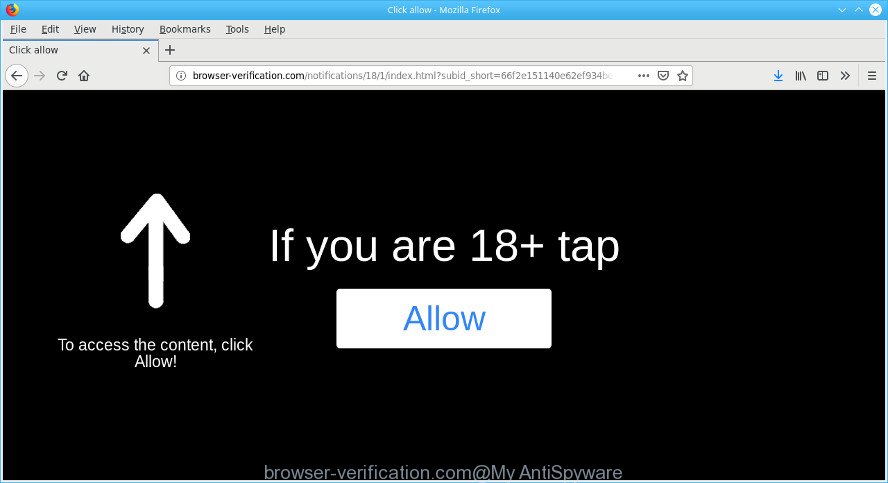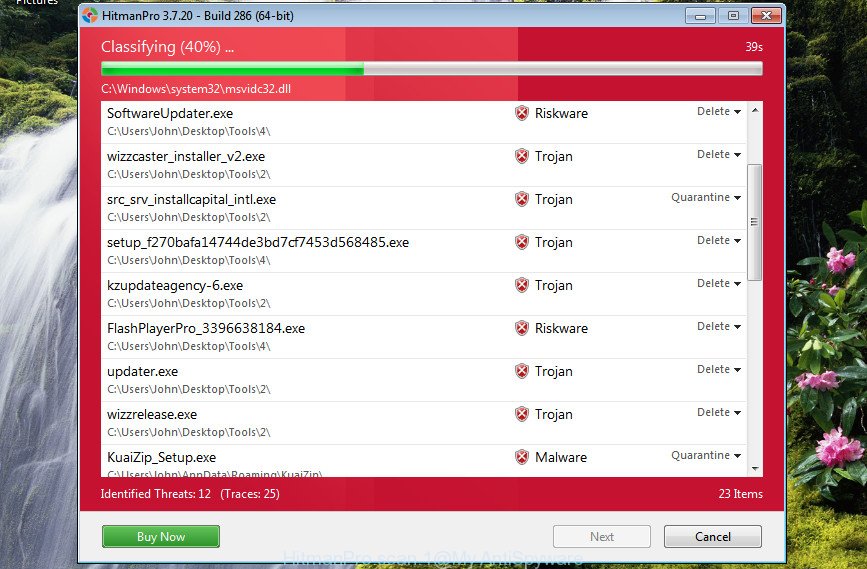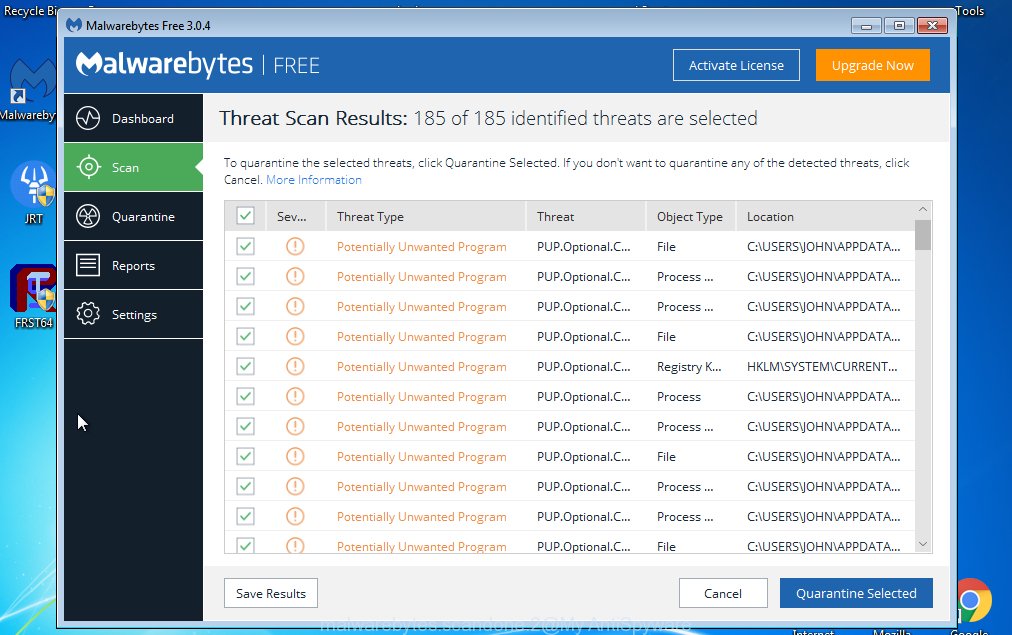Are you facing a problem with the Internet Explorer, Firefox, Edge and Chrome internet browsers that constantly redirects to a questionable web page named Browser-verification.com? Then, there are chances that are your PC system is affected by undesired software from the adware (also known as ‘ad-supported’ software) family.

http://browser-verification.com/notifications/ …
Adware is developed to display annoying pop up deals on the affected PC system. In this blog post we will discuss what ad-supported software is and how can you get rid of Browser-verification.com pop-ups from the IE, Mozilla Firefox, MS Edge and Chrome manually or with free adware removal tools compatible with Windows 10 (8, 7 and XP).
Technically, the adware is not a virus, but it does bad things, it generates a lot of pop up ads. It may download and install on to your system other malicious and unwanted apps without your permission, force you to visit misleading or harmful pages. Moreover, the adware can install a web-browser hijacker. Once installed, it will change your internet browser setting like default search provider, newtab and homepage with an annoying page.
As well as undesired web browser redirections to Browser-verification.com, the ad-supported software can collect your World Wide Web browsing activity by saving URLs visited, IP addresses, browser version and type, cookie information, Internet Service Provider (ISP) and pages visited. Such kind of behavior can lead to serious security problems or user info theft. This is another reason why the ad-supported software that responsible for the appearance of Browser-verification.com pop-up advertisements should be removed immediately.
If you are unfortunate have ad-supported software or malware running on your machine, you can follow the guide here to remove Browser-verification.com pop-ups from your web browser.
Remove Browser-verification.com pop-ups, ads, notifications (removal guide)
There present several free adware removal utilities. Also it is possible to delete Browser-verification.com redirect manually. But we suggest to combine all these solutions below into the one removal algorithm. Follow the steps of the guide. Certain of the steps below will require you to close this web page. So, please read the few simple steps carefully, after that bookmark or print it for later reference.
To remove Browser-verification.com pop-ups, complete the steps below:
- Delete Browser-verification.com pop-ups without any utilities
- How to remove Browser-verification.com popup advertisements with free software
- Use AdBlocker to block Browser-verification.com and stay safe online
- How to avoid install of Browser-verification.com pop-ups
- Finish words
Delete Browser-verification.com pop-ups without any utilities
The few simple steps will help you get rid of Browser-verification.com pop-ups. These Browser-verification.com removal steps work for the Internet Explorer, Mozilla Firefox, Chrome and MS Edge, as well as every version of OS.
Delete adware through the Microsoft Windows Control Panel
Some potentially unwanted apps, browser hijacking programs and adware can be uninstalled by uninstalling the free programs they came with. If this way does not succeed, then looking them up in the list of installed programs in Windows Control Panel. Use the “Uninstall” command in order to remove them.
Windows 10, 8.1, 8
Click the Windows logo, and then click Search ![]() . Type ‘Control panel’and press Enter like below.
. Type ‘Control panel’and press Enter like below.

Once the ‘Control Panel’ opens, press the ‘Uninstall a program’ link under Programs category as shown in the following example.

Windows 7, Vista, XP
Open Start menu and select the ‘Control Panel’ at right as shown on the screen below.

Then go to ‘Add/Remove Programs’ or ‘Uninstall a program’ (Microsoft Windows 7 or Vista) like below.

Carefully browse through the list of installed programs and delete all dubious and unknown applications. We suggest to click ‘Installed programs’ and even sorts all installed programs by date. Once you have found anything dubious that may be the ad supported software that causes web-browsers to open undesired Browser-verification.com ads or other PUP (potentially unwanted program), then select this program and click ‘Uninstall’ in the upper part of the window. If the questionable program blocked from removal, then run Revo Uninstaller Freeware to fully remove it from your computer.
Remove Browser-verification.com pop up ads from Microsoft Internet Explorer
In order to restore all internet browser startpage, newtab and search provider by default you need to reset the Microsoft Internet Explorer to the state, which was when the MS Windows was installed on your machine.
First, launch the Microsoft Internet Explorer, then click ‘gear’ icon ![]() . It will open the Tools drop-down menu on the right part of the web browser, then click the “Internet Options” as shown in the figure below.
. It will open the Tools drop-down menu on the right part of the web browser, then click the “Internet Options” as shown in the figure below.

In the “Internet Options” screen, select the “Advanced” tab, then press the “Reset” button. The Microsoft Internet Explorer will open the “Reset Internet Explorer settings” dialog box. Further, click the “Delete personal settings” check box to select it. Next, click the “Reset” button as shown on the image below.

After the task is complete, click “Close” button. Close the Internet Explorer and restart your computer for the changes to take effect. This step will help you to restore your internet browser’s new tab, search provider by default and start page to default state.
Remove Browser-verification.com popups from Google Chrome
If you have adware, Browser-verification.com pop-up ads problems or Chrome is running slow, then reset Chrome can help you. In this guidance we will show you the method to reset your Google Chrome settings and data to original settings without reinstall.
Open the Chrome menu by clicking on the button in the form of three horizontal dotes (![]() ). It will display the drop-down menu. Select More Tools, then click Extensions.
). It will display the drop-down menu. Select More Tools, then click Extensions.
Carefully browse through the list of installed extensions. If the list has the addon labeled with “Installed by enterprise policy” or “Installed by your administrator”, then complete the following steps: Remove Chrome extensions installed by enterprise policy otherwise, just go to the step below.
Open the Google Chrome main menu again, click to “Settings” option.

Scroll down to the bottom of the page and click on the “Advanced” link. Now scroll down until the Reset settings section is visible, as displayed in the following example and click the “Reset settings to their original defaults” button.

Confirm your action, click the “Reset” button.
Get rid of Browser-verification.com from Mozilla Firefox by resetting browser settings
If Mozilla Firefox settings are hijacked by the ad-supported software, your browser displays undesired popup advertisements, then ‘Reset Mozilla Firefox’ could solve these problems. Essential information such as bookmarks, browsing history, passwords, cookies, auto-fill data and personal dictionaries will not be removed.
First, launch the Mozilla Firefox and click ![]() button. It will show the drop-down menu on the right-part of the browser. Further, press the Help button (
button. It will show the drop-down menu on the right-part of the browser. Further, press the Help button (![]() ) as on the image below.
) as on the image below.

In the Help menu, select the “Troubleshooting Information” option. Another way to open the “Troubleshooting Information” screen – type “about:support” in the browser adress bar and press Enter. It will open the “Troubleshooting Information” page as on the image below. In the upper-right corner of this screen, click the “Refresh Firefox” button.

It will open the confirmation dialog box. Further, click the “Refresh Firefox” button. The Mozilla Firefox will begin a procedure to fix your problems that caused by the Browser-verification.com adware. Once, it’s finished, click the “Finish” button.
How to remove Browser-verification.com popup advertisements with free software
If your PC is still infected with adware that responsible for web browser reroute to the unwanted Browser-verification.com web page, then the best solution of detection and removal is to run an anti-malware scan on the PC. Download free malicious software removal utilities below and start a full system scan. It will help you remove all components of the adware from hardisk and Windows registry.
Remove Browser-verification.com pop-up advertisements with Zemana Free
You can download and use the Zemana Anti-Malware for free. This antimalware tool will scan all the MS Windows registry keys and files in your personal computer along with the system settings and web browser add-ons. If it finds any malware, adware or malicious extension that is responsible for redirecting your browser to Browser-verification.com web-page then the Zemana will delete them from your computer completely.

- Click the following link to download the latest version of Zemana AntiMalware (ZAM) for Microsoft Windows. Save it directly to your Microsoft Windows Desktop.
Zemana AntiMalware
164813 downloads
Author: Zemana Ltd
Category: Security tools
Update: July 16, 2019
- At the download page, click on the Download button. Your browser will open the “Save as” prompt. Please save it onto your Windows desktop.
- Once the downloading process is done, please close all applications and open windows on your computer. Next, launch a file called Zemana.AntiMalware.Setup.
- This will launch the “Setup wizard” of Zemana AntiMalware (ZAM) onto your PC. Follow the prompts and do not make any changes to default settings.
- When the Setup wizard has finished installing, the Zemana AntiMalware (ZAM) will launch and display the main window.
- Further, click the “Scan” button to start scanning your PC system for the adware that causes internet browsers to display undesired Browser-verification.com pop ups. A system scan can take anywhere from 5 to 30 minutes, depending on your computer.
- After Zemana Free has finished scanning your PC, Zemana Anti-Malware will show a list of found items.
- Next, you need to click the “Next” button. The tool will remove adware responsible for redirecting your web-browser to the Browser-verification.com web-site and move items to the program’s quarantine. After that process is finished, you may be prompted to reboot the personal computer.
- Close the Zemana and continue with the next step.
Remove Browser-verification.com pop-ups from internet browsers with HitmanPro
All-in-all, HitmanPro is a fantastic tool to clean your computer from any unwanted software such as ad-supported software related to Browser-verification.com ads. The HitmanPro is portable program that meaning, you do not need to install it to use it. HitmanPro is compatible with all versions of Microsoft Windows operating system from Windows XP to Windows 10. Both 64-bit and 32-bit systems are supported.

- Hitman Pro can be downloaded from the following link. Save it to your Desktop so that you can access the file easily.
- After downloading is done, launch the Hitman Pro, double-click the HitmanPro.exe file.
- If the “User Account Control” prompts, click Yes to continue.
- In the HitmanPro window, click the “Next” . HitmanPro utility will begin scanning the whole PC system to find out adware that responsible for web-browser redirect to the intrusive Browser-verification.com web page. A scan may take anywhere from 10 to 30 minutes, depending on the number of files on your machine and the speed of your personal computer. During the scan Hitman Pro will scan for threats exist on your computer.
- When Hitman Pro has finished scanning, Hitman Pro will display a scan report. Review the scan results and then click “Next”. Now, click the “Activate free license” button to start the free 30 days trial to remove all malware found.
Delete Browser-verification.com popup advertisements with MalwareBytes
We suggest using the MalwareBytes Anti-Malware (MBAM). You can download and install MalwareBytes AntiMalware (MBAM) to detect adware and thereby get rid of Browser-verification.com popup advertisements from your browsers. When installed and updated, this free malware remover automatically scans for and deletes all threats exist on the PC system.

- MalwareBytes Free can be downloaded from the following link. Save it on your Windows desktop.
Malwarebytes Anti-malware
327070 downloads
Author: Malwarebytes
Category: Security tools
Update: April 15, 2020
- At the download page, click on the Download button. Your web browser will open the “Save as” prompt. Please save it onto your Windows desktop.
- After downloading is done, please close all applications and open windows on your personal computer. Double-click on the icon that’s named mb3-setup.
- This will run the “Setup wizard” of MalwareBytes onto your personal computer. Follow the prompts and don’t make any changes to default settings.
- When the Setup wizard has finished installing, the MalwareBytes Free will open and display the main window.
- Further, press the “Scan Now” button for checking your PC system for the ad supported software that causes web browsers to open unwanted Browser-verification.com pop-ups. A system scan can take anywhere from 5 to 30 minutes, depending on your PC system. While the MalwareBytes Free tool is scanning, you can see how many objects it has identified as being affected by malicious software.
- When MalwareBytes has completed scanning your machine, you will be displayed the list of all found items on your PC.
- Review the report and then click the “Quarantine Selected” button. When finished, you may be prompted to reboot the PC.
- Close the Anti Malware and continue with the next step.
Video instruction, which reveals in detail the steps above.
Use AdBlocker to block Browser-verification.com and stay safe online
If you want to get rid of undesired advertisements, web-browser redirects and popups, then install an adblocker program like AdGuard. It can stop Browser-verification.com, ads, pop-ups and stop web sites from tracking your online activities when using the Firefox, MS Edge, Microsoft Internet Explorer and Google Chrome. So, if you like surf the Web, but you do not like undesired ads and want to protect your system from harmful web pages, then the AdGuard is your best choice.
AdGuard can be downloaded from the following link. Save it directly to your Windows Desktop.
26842 downloads
Version: 6.4
Author: © Adguard
Category: Security tools
Update: November 15, 2018
When the downloading process is done, launch the downloaded file. You will see the “Setup Wizard” screen as shown in the following example.

Follow the prompts. After the setup is complete, you will see a window as shown on the screen below.

You can press “Skip” to close the setup application and use the default settings, or click “Get Started” button to see an quick tutorial which will allow you get to know AdGuard better.
In most cases, the default settings are enough and you do not need to change anything. Each time, when you run your computer, AdGuard will start automatically and stop unwanted ads, block Browser-verification.com, as well as other harmful or misleading sites. For an overview of all the features of the application, or to change its settings you can simply double-click on the AdGuard icon, which may be found on your desktop.
How to avoid install of Browser-verification.com pop-ups
The adware usually is bundled within free software which downloaded from the World Wide Web. Which means that you need to be proactive and carefully read the Terms of use and the License agreement properly. For the most part, the adware will be clearly described, so take the time to carefully read all the information about the software that you downloaded and want to install on your personal computer. In the Setup wizard, you should select the Advanced, Custom or Manual install option to control what components and additional applications to be installed, otherwise you run the risk of infecting your computer with an adware like the adware which causes annoying Browser-verification.com pop-ups.
Finish words
Now your system should be clean of the ad-supported software that redirects your browser to the annoying Browser-verification.com page. We suggest that you keep AdGuard (to help you stop unwanted pop up ads and annoying harmful web sites) and Zemana (to periodically scan your machine for new adwares and other malicious software). Probably you are running an older version of Java or Adobe Flash Player. This can be a security risk, so download and install the latest version right now.
If you are still having problems while trying to remove Browser-verification.com advertisements from the Microsoft Internet Explorer, Edge, Chrome and Mozilla Firefox, then ask for help here here.


















